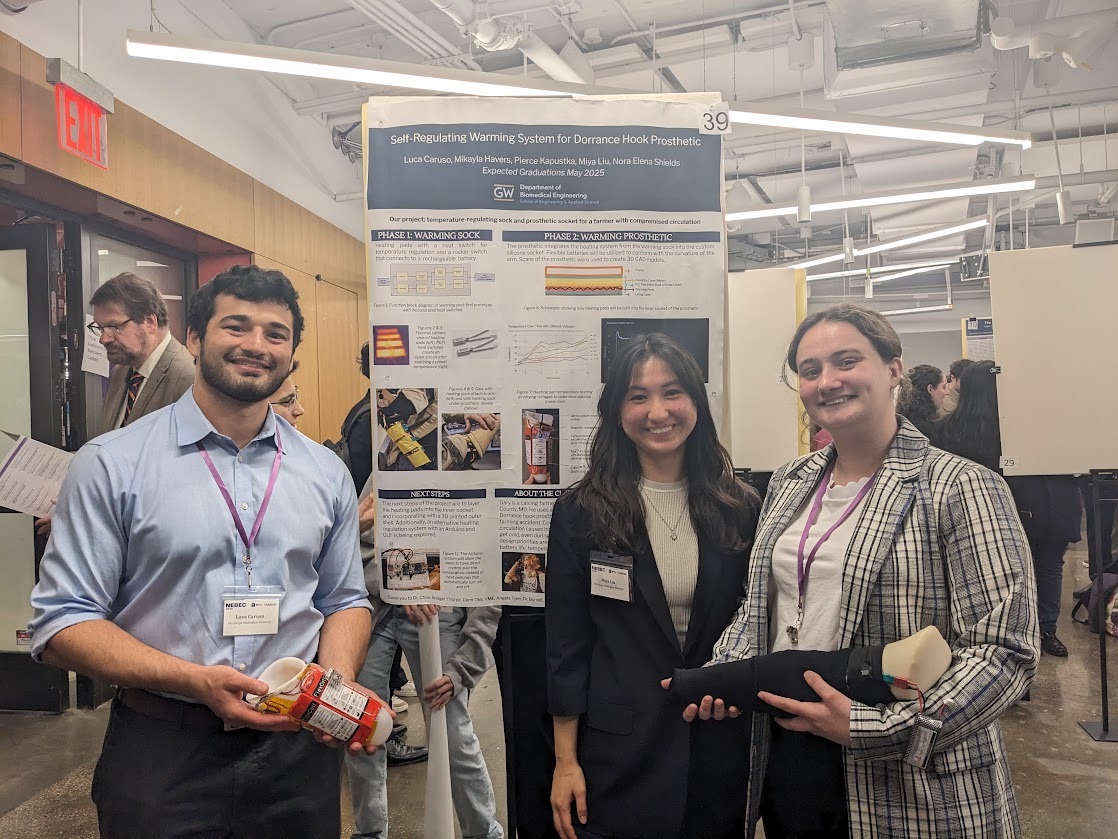Students from GW Engineering’s Department of Biomedical Engineering (BME) showcased their commitment to advancing healthcare at the 2025 Northeast Bioengineering Conference (NEBEC) on April 4 and 5. Guided by Associate Professor of Practice Nathan Choe, two student teams presented their innovative capstone projects, including an award-winning self-regulating warming system for integration into a local farmer’s prosthetic arm.
Hosted annually by New York University’s Tandon School of Engineering, NEBEC is a premier regional event for researchers, industry professionals, and students to gather and exchange knowledge. This year's theme, “Engineering the Future of Healthcare,” reflected the conference program's focus on emerging developments in the field.
On behalf of her team, Miya Liu, a mechanical and aerospace engineering (MAE) student, shared, “It was incredible seeing the cutting-edge side of academia and what the future of bioengineering will look like in the next few decades. We were fascinated by how general engineering concepts, like imaging, robotics, or microelectrodes, can be applied across the field to save and improve people’s lives. Our favorite part was talking to other student teams to see their design processes and exchange ideas and experiences.”
Liu, alongside BME students Luca Caruso, Mikayla Havers, Pierce Kapustka, and Nora Elena Shields, won one of the conference’s Best Senior Project Design Awards for their project, “Self-Regulating Warming System for Dorrance Hook Prosthetic.” The team designed and fabricated two unique arm-warming prostheses with built-in rechargeable batteries for Gary, a 67-year-old Maryland farmer who recently became an amputee. Gary’s compromised circulation causes his wrist and forearm to constantly feel cold, making daily farm chores difficult.
Collaborating with Direct Dimensions and Volunteers for Medical Engineering, the team produced a warming sock and a socket prosthetic. They faced challenges along the way, such as Gary’s difficulty putting the warming sock on with one hand, underscoring the importance of user-centric design. The students also gained hands-on experience with a portable 3D scanner during a visit to Direct Dimensions, where they worked alongside Gary to capture precise data of his residual limb, which was critical for designing a prosthetic socket tailored to him.
“We are beyond grateful to Professor Choe and Angela Taylor at Volunteers for Medical Engineering for the opportunity to work directly with Farmer Gary as a client, as well as the abundance of mentorship and resources that they provided. Over the past two semesters, we encountered many difficult roadblocks, but always kept “Amazing Farmer Gary,” as he refers to himself, in mind. This has pushed us to produce devices that we are truly proud of,” said Liu.
While her team focused on solving a patient-specific issue, the second BME team’s project, “Smart Bandage with Moisture Sensor and Time for Wound Monitoring,” tackled a broader challenge in clinical care: improving wound management. Team members Kate McLean, Alice Tchangoum, Jade Balansag, Amarachi Elekeokwuri, and Kate Olid developed two complementary devices to help healthcare workers quickly access wound care information and track moisture levels for timely dressing changes, aiming to enhance patient quality measures.
Both projects underscore the vital role of biomedical engineering in developing innovative healthcare solutions that address real patient needs. Attending NBEC 2025 provided the student teams with a platform to showcase their designs while gaining invaluable exposure to the broader bioengineering community.


